A Comparative Analysis of Two Passages in Christian Doctrines
VerifiedAdded on 2022/09/26
|5
|1038
|25
Essay
AI Summary
This essay provides an analysis of two key passages within Christian doctrines: the Mosaic Covenant and the Good Samaritan, along with the Prodigal Son. The paper begins by outlining the Mosaic Covenant, emphasizing its conditional nature as a deal between God and the Israelites, and contrasts it with the unconditional love central to Christianity. The essay then summarizes the parable of the Good Samaritan and Prodigal Son, highlighting Jesus Christ's benevolent nature and teachings on love and compassion. It explores how the second passage underscores the importance of loving one's neighbor. The conclusion emphasizes the informative nature of both passages and the boundless love of God and Jesus Christ.
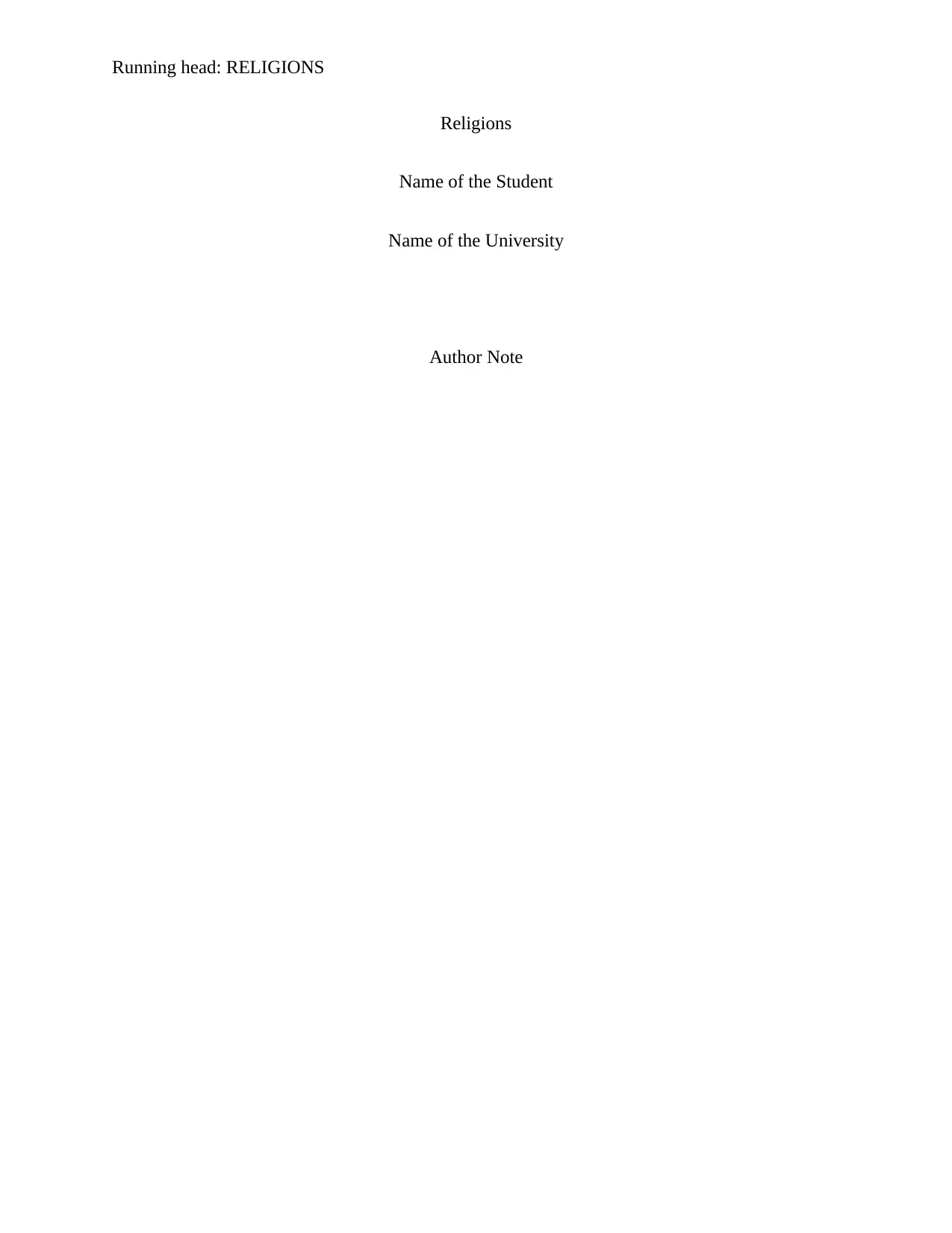
Running head: RELIGIONS
Religions
Name of the Student
Name of the University
Author Note
Religions
Name of the Student
Name of the University
Author Note
Paraphrase This Document
Need a fresh take? Get an instant paraphrase of this document with our AI Paraphraser
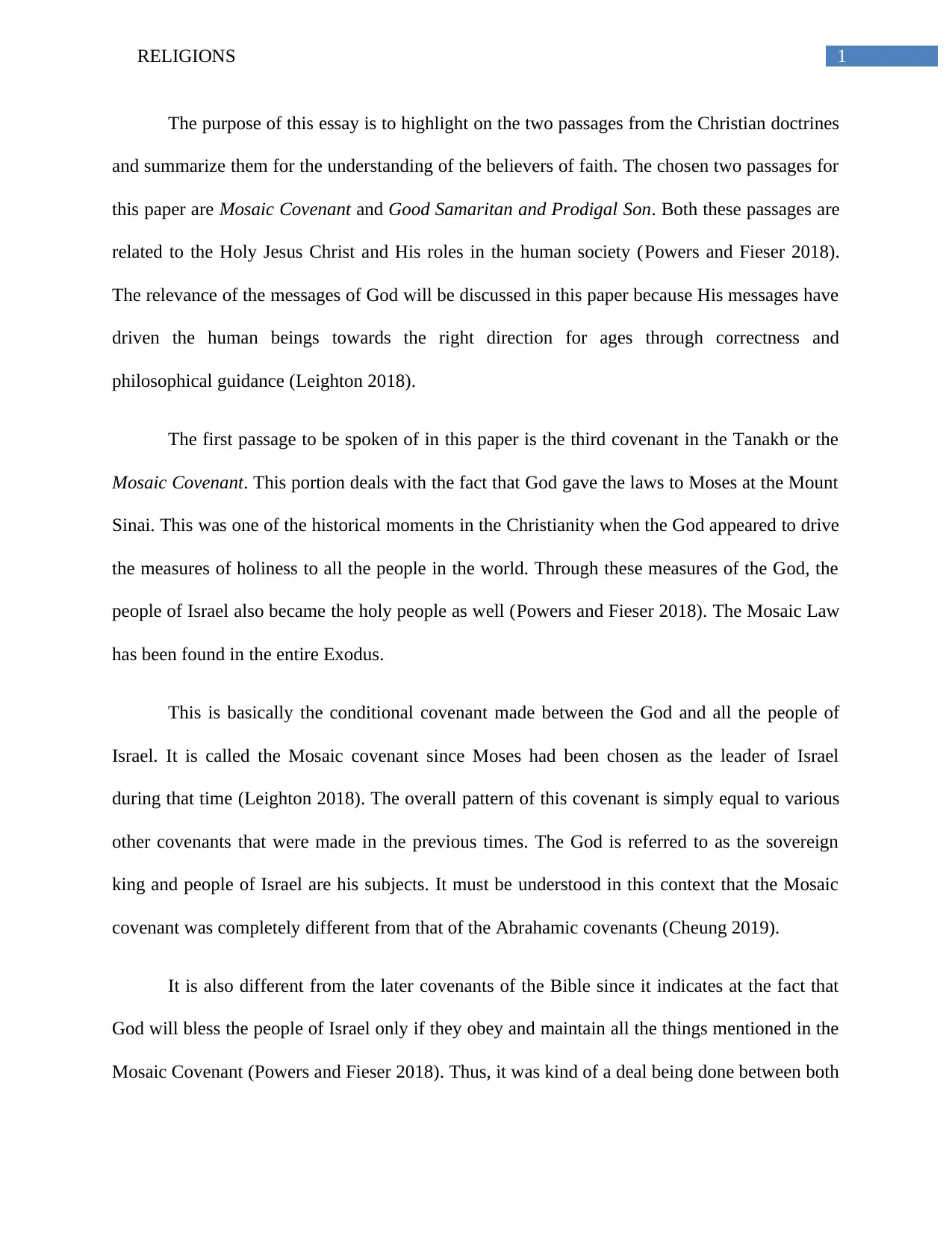
1RELIGIONS
The purpose of this essay is to highlight on the two passages from the Christian doctrines
and summarize them for the understanding of the believers of faith. The chosen two passages for
this paper are Mosaic Covenant and Good Samaritan and Prodigal Son. Both these passages are
related to the Holy Jesus Christ and His roles in the human society (Powers and Fieser 2018).
The relevance of the messages of God will be discussed in this paper because His messages have
driven the human beings towards the right direction for ages through correctness and
philosophical guidance (Leighton 2018).
The first passage to be spoken of in this paper is the third covenant in the Tanakh or the
Mosaic Covenant. This portion deals with the fact that God gave the laws to Moses at the Mount
Sinai. This was one of the historical moments in the Christianity when the God appeared to drive
the measures of holiness to all the people in the world. Through these measures of the God, the
people of Israel also became the holy people as well (Powers and Fieser 2018). The Mosaic Law
has been found in the entire Exodus.
This is basically the conditional covenant made between the God and all the people of
Israel. It is called the Mosaic covenant since Moses had been chosen as the leader of Israel
during that time (Leighton 2018). The overall pattern of this covenant is simply equal to various
other covenants that were made in the previous times. The God is referred to as the sovereign
king and people of Israel are his subjects. It must be understood in this context that the Mosaic
covenant was completely different from that of the Abrahamic covenants (Cheung 2019).
It is also different from the later covenants of the Bible since it indicates at the fact that
God will bless the people of Israel only if they obey and maintain all the things mentioned in the
Mosaic Covenant (Powers and Fieser 2018). Thus, it was kind of a deal being done between both
The purpose of this essay is to highlight on the two passages from the Christian doctrines
and summarize them for the understanding of the believers of faith. The chosen two passages for
this paper are Mosaic Covenant and Good Samaritan and Prodigal Son. Both these passages are
related to the Holy Jesus Christ and His roles in the human society (Powers and Fieser 2018).
The relevance of the messages of God will be discussed in this paper because His messages have
driven the human beings towards the right direction for ages through correctness and
philosophical guidance (Leighton 2018).
The first passage to be spoken of in this paper is the third covenant in the Tanakh or the
Mosaic Covenant. This portion deals with the fact that God gave the laws to Moses at the Mount
Sinai. This was one of the historical moments in the Christianity when the God appeared to drive
the measures of holiness to all the people in the world. Through these measures of the God, the
people of Israel also became the holy people as well (Powers and Fieser 2018). The Mosaic Law
has been found in the entire Exodus.
This is basically the conditional covenant made between the God and all the people of
Israel. It is called the Mosaic covenant since Moses had been chosen as the leader of Israel
during that time (Leighton 2018). The overall pattern of this covenant is simply equal to various
other covenants that were made in the previous times. The God is referred to as the sovereign
king and people of Israel are his subjects. It must be understood in this context that the Mosaic
covenant was completely different from that of the Abrahamic covenants (Cheung 2019).
It is also different from the later covenants of the Bible since it indicates at the fact that
God will bless the people of Israel only if they obey and maintain all the things mentioned in the
Mosaic Covenant (Powers and Fieser 2018). Thus, it was kind of a deal being done between both
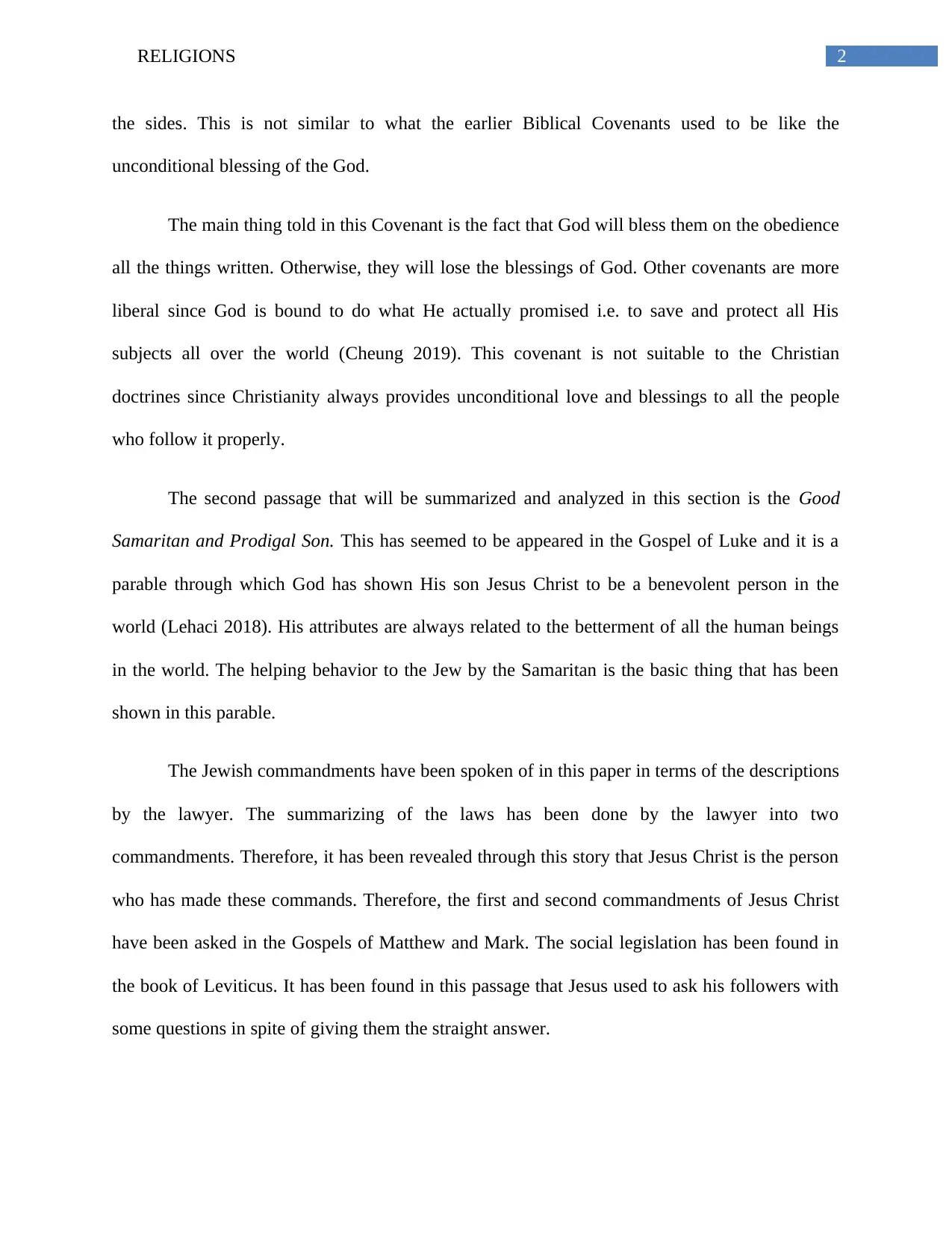
2RELIGIONS
the sides. This is not similar to what the earlier Biblical Covenants used to be like the
unconditional blessing of the God.
The main thing told in this Covenant is the fact that God will bless them on the obedience
all the things written. Otherwise, they will lose the blessings of God. Other covenants are more
liberal since God is bound to do what He actually promised i.e. to save and protect all His
subjects all over the world (Cheung 2019). This covenant is not suitable to the Christian
doctrines since Christianity always provides unconditional love and blessings to all the people
who follow it properly.
The second passage that will be summarized and analyzed in this section is the Good
Samaritan and Prodigal Son. This has seemed to be appeared in the Gospel of Luke and it is a
parable through which God has shown His son Jesus Christ to be a benevolent person in the
world (Lehaci 2018). His attributes are always related to the betterment of all the human beings
in the world. The helping behavior to the Jew by the Samaritan is the basic thing that has been
shown in this parable.
The Jewish commandments have been spoken of in this paper in terms of the descriptions
by the lawyer. The summarizing of the laws has been done by the lawyer into two
commandments. Therefore, it has been revealed through this story that Jesus Christ is the person
who has made these commands. Therefore, the first and second commandments of Jesus Christ
have been asked in the Gospels of Matthew and Mark. The social legislation has been found in
the book of Leviticus. It has been found in this passage that Jesus used to ask his followers with
some questions in spite of giving them the straight answer.
the sides. This is not similar to what the earlier Biblical Covenants used to be like the
unconditional blessing of the God.
The main thing told in this Covenant is the fact that God will bless them on the obedience
all the things written. Otherwise, they will lose the blessings of God. Other covenants are more
liberal since God is bound to do what He actually promised i.e. to save and protect all His
subjects all over the world (Cheung 2019). This covenant is not suitable to the Christian
doctrines since Christianity always provides unconditional love and blessings to all the people
who follow it properly.
The second passage that will be summarized and analyzed in this section is the Good
Samaritan and Prodigal Son. This has seemed to be appeared in the Gospel of Luke and it is a
parable through which God has shown His son Jesus Christ to be a benevolent person in the
world (Lehaci 2018). His attributes are always related to the betterment of all the human beings
in the world. The helping behavior to the Jew by the Samaritan is the basic thing that has been
shown in this parable.
The Jewish commandments have been spoken of in this paper in terms of the descriptions
by the lawyer. The summarizing of the laws has been done by the lawyer into two
commandments. Therefore, it has been revealed through this story that Jesus Christ is the person
who has made these commands. Therefore, the first and second commandments of Jesus Christ
have been asked in the Gospels of Matthew and Mark. The social legislation has been found in
the book of Leviticus. It has been found in this passage that Jesus used to ask his followers with
some questions in spite of giving them the straight answer.
⊘ This is a preview!⊘
Do you want full access?
Subscribe today to unlock all pages.

Trusted by 1+ million students worldwide
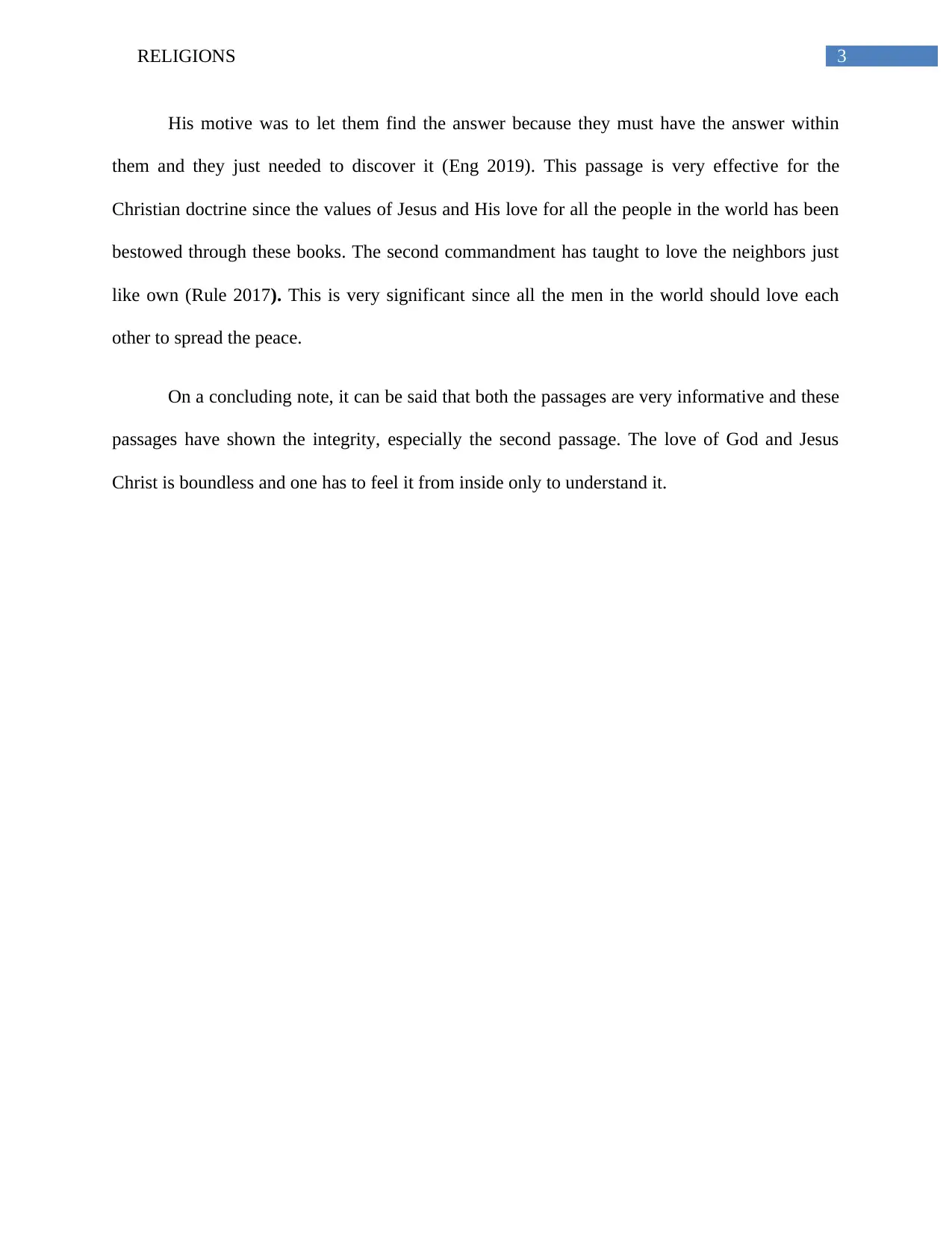
3RELIGIONS
His motive was to let them find the answer because they must have the answer within
them and they just needed to discover it (Eng 2019). This passage is very effective for the
Christian doctrine since the values of Jesus and His love for all the people in the world has been
bestowed through these books. The second commandment has taught to love the neighbors just
like own (Rule 2017). This is very significant since all the men in the world should love each
other to spread the peace.
On a concluding note, it can be said that both the passages are very informative and these
passages have shown the integrity, especially the second passage. The love of God and Jesus
Christ is boundless and one has to feel it from inside only to understand it.
His motive was to let them find the answer because they must have the answer within
them and they just needed to discover it (Eng 2019). This passage is very effective for the
Christian doctrine since the values of Jesus and His love for all the people in the world has been
bestowed through these books. The second commandment has taught to love the neighbors just
like own (Rule 2017). This is very significant since all the men in the world should love each
other to spread the peace.
On a concluding note, it can be said that both the passages are very informative and these
passages have shown the integrity, especially the second passage. The love of God and Jesus
Christ is boundless and one has to feel it from inside only to understand it.
Paraphrase This Document
Need a fresh take? Get an instant paraphrase of this document with our AI Paraphraser
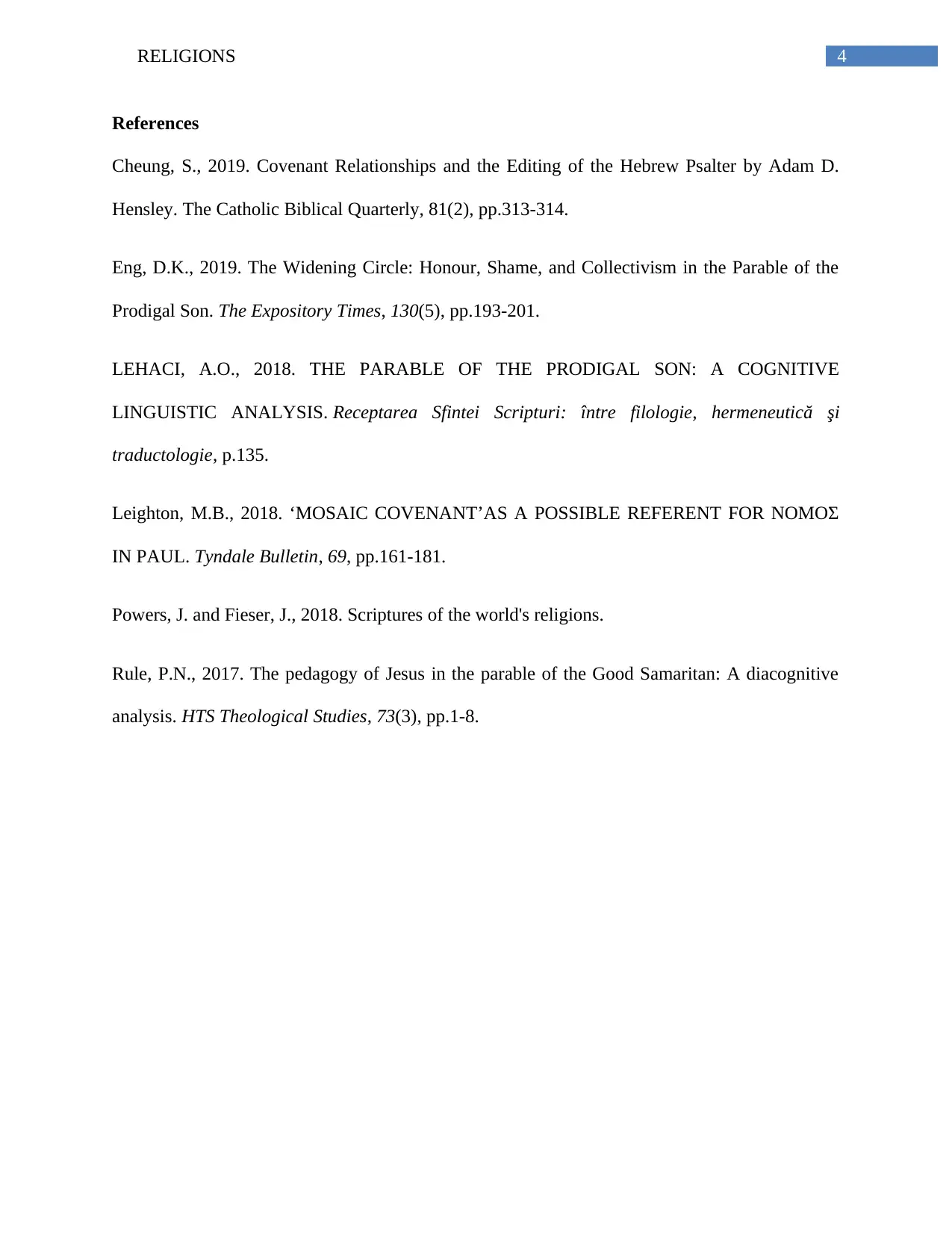
4RELIGIONS
References
Cheung, S., 2019. Covenant Relationships and the Editing of the Hebrew Psalter by Adam D.
Hensley. The Catholic Biblical Quarterly, 81(2), pp.313-314.
Eng, D.K., 2019. The Widening Circle: Honour, Shame, and Collectivism in the Parable of the
Prodigal Son. The Expository Times, 130(5), pp.193-201.
LEHACI, A.O., 2018. THE PARABLE OF THE PRODIGAL SON: A COGNITIVE
LINGUISTIC ANALYSIS. Receptarea Sfintei Scripturi: între filologie, hermeneutică şi
traductologie, p.135.
Leighton, M.B., 2018. ‘MOSAIC COVENANT’AS A POSSIBLE REFERENT FOR ΝΟΜΟΣ
IN PAUL. Tyndale Bulletin, 69, pp.161-181.
Powers, J. and Fieser, J., 2018. Scriptures of the world's religions.
Rule, P.N., 2017. The pedagogy of Jesus in the parable of the Good Samaritan: A diacognitive
analysis. HTS Theological Studies, 73(3), pp.1-8.
References
Cheung, S., 2019. Covenant Relationships and the Editing of the Hebrew Psalter by Adam D.
Hensley. The Catholic Biblical Quarterly, 81(2), pp.313-314.
Eng, D.K., 2019. The Widening Circle: Honour, Shame, and Collectivism in the Parable of the
Prodigal Son. The Expository Times, 130(5), pp.193-201.
LEHACI, A.O., 2018. THE PARABLE OF THE PRODIGAL SON: A COGNITIVE
LINGUISTIC ANALYSIS. Receptarea Sfintei Scripturi: între filologie, hermeneutică şi
traductologie, p.135.
Leighton, M.B., 2018. ‘MOSAIC COVENANT’AS A POSSIBLE REFERENT FOR ΝΟΜΟΣ
IN PAUL. Tyndale Bulletin, 69, pp.161-181.
Powers, J. and Fieser, J., 2018. Scriptures of the world's religions.
Rule, P.N., 2017. The pedagogy of Jesus in the parable of the Good Samaritan: A diacognitive
analysis. HTS Theological Studies, 73(3), pp.1-8.
1 out of 5
Your All-in-One AI-Powered Toolkit for Academic Success.
+13062052269
info@desklib.com
Available 24*7 on WhatsApp / Email
![[object Object]](/_next/static/media/star-bottom.7253800d.svg)
Unlock your academic potential
Copyright © 2020–2025 A2Z Services. All Rights Reserved. Developed and managed by ZUCOL.
